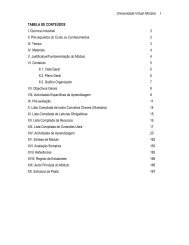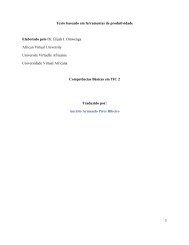Physical Chemistry 2.pdf - OER@AVU - African Virtual University
Physical Chemistry 2.pdf - OER@AVU - African Virtual University
Physical Chemistry 2.pdf - OER@AVU - African Virtual University
You also want an ePaper? Increase the reach of your titles
YUMPU automatically turns print PDFs into web optimized ePapers that Google loves.
sp =<br />
c<br />
p<br />
k<br />
<strong>African</strong> <strong>Virtual</strong> <strong>University</strong><br />
s<br />
2<br />
= k1<br />
+ k2c<br />
+ k3c<br />
sp<br />
(2.11)<br />
c = k<br />
c<br />
The value of ç s p can be determined by extrapolating to infinite dilution a plot of ç s p<br />
against c. c<br />
c<br />
sp a 2<br />
[ ]<br />
= KM<br />
Approximate<br />
= k1<br />
+ k<br />
molar 2c<br />
+ k3c<br />
c<br />
masses are easily determined using the Mark-Houwink equation<br />
[ ]<br />
= KM<br />
a<br />
(2.12)<br />
The constants K and a are characteristic of a particular polymer-solvent system.<br />
(e) Electrical particles. Colloidal particles are affected by charges adsorbed on the<br />
surface of the particles. Charges are adsorbed when particles are dispersed in a liquid<br />
medium, an electric double layer forms around the particle as shown in the Figure 2.4<br />
below. Such a system can be attained by adding a salt, for example potassium iodide,<br />
to a dilute solution. The stability of a colloidal system is affected by the presence and<br />
magnitude of a charge on a particle. The presence of a charge on particle creates a<br />
shield that prevents coalescence of the particles via mutual repulsion. Lyophobic sols<br />
are thermodynamically unstable, the presence of electrical charges impart stability<br />
due to repulsions that prevent coagulation.<br />
Particle surface<br />
+<br />
+ − +<br />
+ +<br />
+<br />
+<br />
+<br />
+<br />
+<br />
−<br />
+<br />
+<br />
+ −<br />
+<br />
+ −<br />
Fixed portion of<br />
the double layer<br />
Mobile or diffuse portion<br />
+<br />
+<br />
+<br />
Bulk solution<br />
+ + + + +<br />
+ + + + +<br />
+ + + + +<br />
+ + +<br />
Figure 2.4 Illustration of double layer formation in the vicinity of a colloidal<br />
particle. Diagram shows the position of the particle, diffuse<br />
portion and the bulk solution.
















